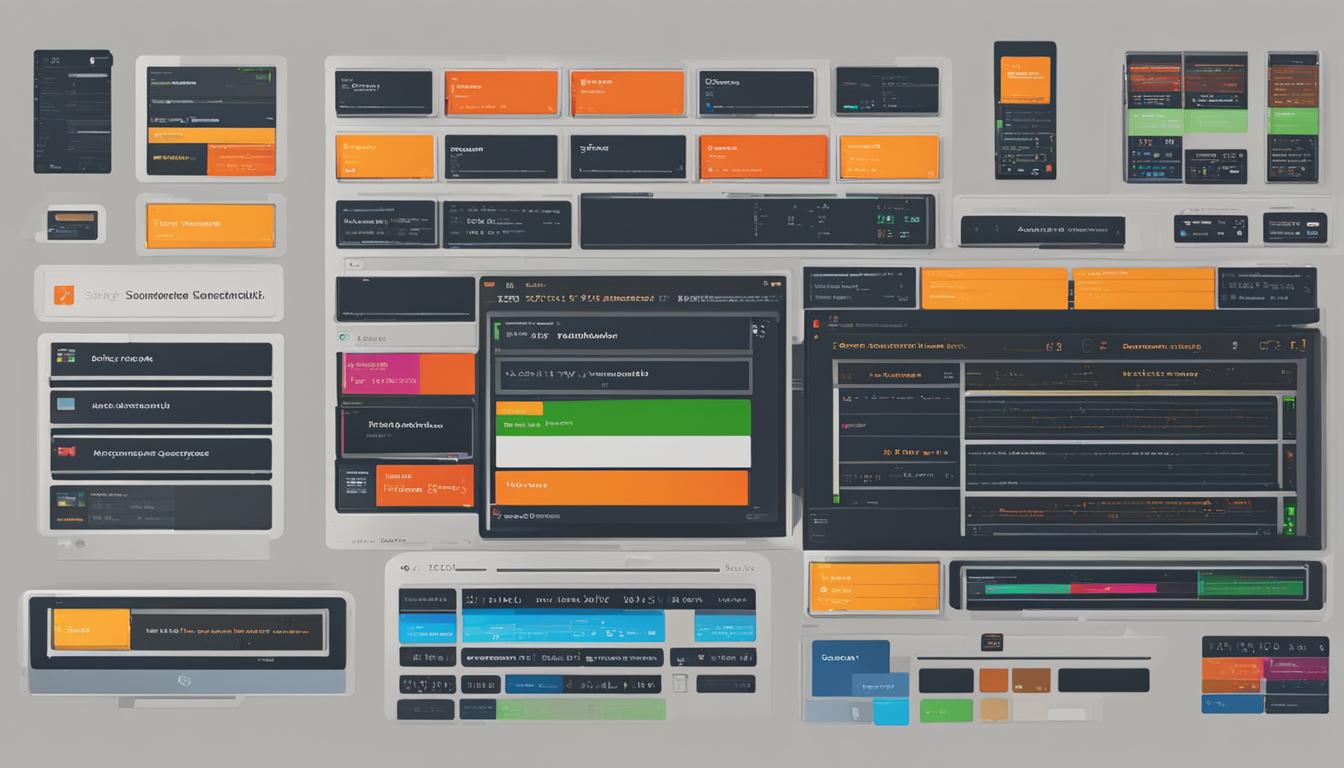Understanding Bash (Bourne Again SHell): What is Bash?
As a journalist and copywriting expert, I am excited to delve into the world of Bash (Bourne Again SHell) and explore its significance in the realm of Unix shell scripting. Bash, a command-line interpreter and scripting language, is widely used in Linux scripting and plays a pivotal role in executing complex tasks efficiently. Let’s uncover the fundamentals of Bash, its features, and its applications.
Key Takeaways:
- Bash is a powerful Unix shell and scripting language.
- It is a command-line interpreter used in Linux scripting and shell scripting.
- Bash offers a range of features inherited from the original Bourne shell and other shells like Korn shell and C shell.
- It is released under the GNU General Public License (GPL) and is designed to be compatible with Bourne shell programs.
- Bash is widely used by system administrators, software developers, network engineers, researchers, and hobbyists for various tasks.
What is a Shell?
A shell program is an integral part of an operating system that provides a user interface for interacting with the system’s components. It acts as an intermediary between users or other programs and the underlying system itself. There are two main types of shells: command-line interface (CLI) shells and graphical user interface (GUI) shells.
CLI shells, such as Bash, offer a concise and efficient mode of interacting with the operating system through a command-line interface. This type of shell allows users to enter commands and receive immediate feedback from the system. CLI shells are favored by system administrators, developers, and power users because of their speed, flexibility, and the ability to automate tasks using scripting languages like Bash.
On the other hand, GUI shells, like those used in Windows and macOS, provide a more user-friendly interface with visual elements such as windows, icons, buttons, and menus. This type of shell is commonly used by casual computer users who prefer a point-and-click approach to interact with the system.
As a command-line interface shell, Bash excels in providing a powerful and versatile environment for users to interact with Unix-based operating systems, including Linux.
CLI Shells vs. GUI Shells
| CLI Shells | GUI Shells |
|---|---|
| Require typing commands | Use visual elements like windows and buttons |
| Concise and efficient | User-friendly interface |
| Preferred by system administrators, developers, and power users | Preferred by casual computer users |
| Allows automation through scripting languages | Relies on point-and-click interactions |
“A CLI shell like Bash provides a streamlined and efficient way to interact with an operating system, offering powerful functionality and the ability to automate tasks through scripting.”
What is Bash Used For?
Bash is a versatile tool used in a variety of computer applications across different fields. Let’s explore some of the main use cases where Bash is widely utilized:
System Administrators:
- Managing systems
- Troubleshooting
- Distributing software updates
- Monitoring running systems
- Configuring systems
Software Developers:
- Automating software development tasks
- Compiling code
- Debugging
- Change management
- Software testing
Network Engineers:
- Testing network performance
- Configuring network settings
- Optimizing network performance
Computer Science Researchers:
- Managing research systems
- Carrying out research tasks
Hobbyists and Power Users:
- Interacting with their systems
- Maintaining and customizing their systems
In addition to these specific use cases, Bash is also commonly used to write Bash scripts, which can automate almost any computer task. These scripts can be run on-demand or scheduled to run periodically, providing further efficiency and automation for various tasks.
Overall, Bash is highly valued for its precision and efficiency when working with files and data, making it an essential tool for many professionals in the technology field.
Table: Bash Use Cases
| Field | Use Cases |
|---|---|
| System Administrators | Managing systems Troubleshooting Distributing software updates Monitoring running systems Configuring systems |
| Software Developers | Automating software development tasks Compiling code Debugging Change management Software testing |
| Network Engineers | Testing network performance Configuring network settings Optimizing network performance |
| Computer Science Researchers | Managing research systems Carrying out research tasks |
| Hobbyists and Power Users | Interacting with systems Maintaining and customizing systems |
How Does Bash Work?
Bash works by executing commands entered by the user or read from a file. Each command performs a specific action, such as listing directory contents or manipulating files. The ls command, for example, lists files and subdirectories in the current working directory. It can be used with command-line arguments to modify its behavior, such as displaying detailed file information or listing hidden files.
Bash enables combining commands through command piping, which directs the output of one command to be used as input for another command. This powerful feature allows users to chain commands together, creating complex operations with ease. For example, the following command lists all files in the current directory that have the “.txt” extension:
Bash also supports command lists and compound commands, which allow users to run multiple commands in sequence or execute commands conditionally. Command-line editing is another essential feature of Bash, which allows users to recall and modify previous commands easily. With command history, users can navigate through their command-line inputs, making edits or reusing them as needed.
Overall, Bash provides a flexible and efficient environment for executing commands and automating tasks through its various features, making it a popular choice for both beginners and experienced users in the Unix-based operating systems.
Table: Bash Commands
| Command | Description |
|---|---|
| cd | Change directory |
| ls | List directory contents |
| mkdir | Create a directory |
| cp | Copy files and directories |
| mv | Move or rename files and directories |
| rm | Remove files and directories |
| cat | Concatenate and view file contents |
Bash Features and History
Bash, also known as Bourne Again Shell, offers several features that make it a popular choice among developers and system administrators. It was developed as a replacement for the original Bourne shell and has since evolved to include enhanced functionality and improved performance.
One of the notable features of Bash is its support for command substitution. This allows the output of one command to be used as the input for another command, enabling complex operations to be performed with ease. Additionally, Bash introduced associative arrays, which offer a more flexible and efficient way to store and manipulate data.
Another powerful feature of Bash is brace expansion. This feature allows users to generate alternative combinations and sequential ranges for command arguments, making it easier to perform repetitive tasks and automate workflows. With these features and more, Bash has become a versatile tool for scripting and automation in various domains.
Bash has had its share of security vulnerabilities in the past, including the infamous Shellshock bug discovered in 2014. However, the Bash community has been proactive in addressing these issues and releasing patches to ensure the shell remains secure and reliable for users.
| Feature | Description |
|---|---|
| Command Substitution | Allows the output of one command to be used as input for another command |
| Associative Arrays | Enables the storage and manipulation of data using key-value pairs |
| Brace Expansion | Generates alternative combinations and sequential ranges for command arguments |
Despite its vulnerabilities, Bash remains widely used and continues to be actively developed and maintained. Its rich history, dating back to its initial release in 1989, is a testament to its popularity and longevity in the world of scripting and automation.
References:
- GNU Bash
- Linux Journal – Introduction to Bash Scripting
Bash as a Versatile Interface
Bash, while commonly known as a powerful command-line interface (CLI) shell, has capabilities that extend far beyond traditional terminal usage. In fact, it can be utilized as a versatile interface for a wide range of tasks, including desktop applications, word processing, image editing, multimedia playback, and even web browsing.
One of the remarkable aspects of Bash is its ability to perform functions typically associated with dedicated desktop applications. For instance, Bash commands like ‘cat’, ‘less’, and ‘sed’ can be used to view and manipulate text files, making it a capable word processor. Additionally, tools like ‘imagemagick’ and ‘convert’ allow for image editing functionalities, such as resizing, cropping, and applying filters.
When it comes to multimedia, Bash can handle audio and video tasks with ease. Commands like ‘ogg123’ and ‘mpg321’ can be used to play music files directly from the terminal, while ‘ffmpeg’ offers comprehensive video editing capabilities. Whether it’s cropping videos, adding special effects, or converting file formats, Bash provides the necessary tools.
Furthermore, Bash can serve as a lightweight web browsing tool through ‘elinks’. While it may not offer the graphical richness of traditional browsers, it allows for command-line access to websites, making it useful in certain scenarios where GUI browsers may not be available or preferred.
| Interface | Bash Command |
|---|---|
| Word Processing | cat, less, ln, sed |
| Image Editing | imagemagick, convert, mogrify |
| Audio Playback | ogg123, mpg321 |
| Video Editing | ffmpeg, sox |
| Web Browsing | elinks, w3m |
With the vast array of functionalities offered by Bash, it is clear that it is more than just a command-line shell. Its versatility makes it a valuable tool for users across various domains, allowing them to accomplish tasks efficiently and effectively without the need for dedicated desktop applications.
Bash in Data Science
As data science continues to evolve, the role of Bash (Bourne Again Shell) in this field has become increasingly prominent. Bash offers a simple and efficient way to perform data-related tasks, making it a valuable tool for data scientists. From data collection to data preparation and analysis, Bash scripting allows for automation of complex data pipelines, saving time and effort in the process.
One of the key advantages of using Bash in data science is its efficiency in handling large datasets. Many Linux commands available in Bash are optimized for data-related tasks, allowing for faster processing and analysis. Whether you’re extracting data from various sources, cleaning and transforming data, or performing statistical analysis, Bash provides a streamlined approach to working with data.
Scripting data pipelines is another area where Bash shines in data science. With Bash, data scientists can create robust and automated workflows for data collection, preparation, and analysis. By utilizing the power of Bash scripting, repetitive tasks can be easily automated, freeing up valuable time for more critical analysis and decision-making.
Overall, Bash is a versatile tool that brings efficiency and automation to data science workflows. Its ability to handle large datasets, script data pipelines, and provide cross-platform compatibility makes it an invaluable asset for data scientists. By incorporating Bash into their toolkit, data scientists can maximize their productivity and achieve faster and more accurate results in their data-driven projects.
Bash in Machine Learning
In the field of machine learning, Bash plays a vital role in various stages of the workflow, including data collection, data preparation, and mathematical modeling. The versatility and portability of Bash across different operating systems make it an invaluable tool for machine learning practitioners.
When it comes to data collection, Bash provides a simple and efficient way to automate the process. By scripting commands, data scientists can gather large amounts of data from various sources and store it in a suitable format for further analysis. This automation saves significant time and effort, allowing researchers to focus on other critical aspects of their machine learning projects.
In addition to data collection, Bash is also instrumental in data preparation. Preparing data for machine learning models often involves cleaning, transforming, and aggregating datasets. Bash’s command-line tools and scripting capabilities make these tasks more manageable and scalable. By leveraging Bash, data scientists can manipulate data efficiently and ensure it is in the desired format for training their models.
Using Bash in machine learning allows for automation of data collection and preparation tasks, leading to significant time savings and streamlined workflows. It provides a portable solution across different operating systems, allowing researchers to work seamlessly in various environments.
Mathematical modeling is a fundamental aspect of machine learning, and Bash’s ability to handle complex calculations makes it a valuable asset. Bash supports various mathematical operations, including arithmetic, logic, and statistical computations. By combining Bash with other tools and programming languages, such as Python or R, machine learning practitioners can create sophisticated models and perform advanced analyses.
In summary, Bash in machine learning offers efficiency, automation, and portability. From data collection to mathematical modeling, Bash provides the necessary tools and flexibility for practitioners to tackle complex machine learning projects. By harnessing the power of Bash, data scientists can expedite their workflows and focus on unlocking insights from their data.

Learning Bash
If you’re interested in harnessing the power and versatility of Bash, learning the language is essential. Bash is available for a variety of operating systems, including Linux, macOS, and Windows, making it widely accessible to users. To begin learning Bash, you can easily download and install it from the software center, software repositories, or package managers. Compatibility with POSIX ensures that your Bash scripts can run on any POSIX-compliant operating system.
To help you get started, there are plenty of resources available online, including documentation and tutorials. These resources cater to both beginners who are just starting with Bash and advanced users looking to deepen their understanding of the shell. By investing time and effort into learning Bash, you’ll unlock a powerful tool that can automate tasks, streamline workflows, and make you more efficient in your work.
Learning Bash Installation
To install Bash on your operating system, follow these general steps:
- Open the software center or package manager specific to your operating system.
- Search for “Bash” or “Bourne Again Shell” in the search bar.
- Select Bash from the search results and click on the install button.
- Wait for the installation process to complete.
Availability on Different Operating Systems
Bash is available on various operating systems, including:
- Linux distributions such as Ubuntu, Fedora, and CentOS.
- macOS
- Windows (through tools like Git Bash or Windows Subsystem for Linux)
These different versions of Bash may have slight variations or additional features specific to each operating system, but the core functionality remains the same. Regardless of the operating system you use, learning Bash will provide you with a valuable skillset for managing and automating tasks on the command line.
Bash as Part of DataScientest Training Programs
DataScientest offers comprehensive training programs in the field of Data Science, which include Bash as part of the curriculum. The Data Engineer training program focuses on building data acquisition and automatic data processing pipelines, deploying machine learning models in production servers, and defining a comprehensive data strategy. Bash is taught within the dedicated programming module, alongside the Python language. The Machine Learning Engineer training program is designed for individuals interested in developing APIs, automating deployment processes and data pipelines, and putting machine learning pipelines into production. Bash is also included in the programming module of this program, alongside advanced Python, Linux, and virtual environments.
By incorporating Bash into its training programs, DataScientest equips students with the necessary skills to work with tools and technologies commonly used in the industry. Learning Bash provides students with a solid foundation in shell scripting, enabling them to automate tasks, streamline workflows, and enhance efficiency. The inclusion of Bash in the programming module offers a comprehensive learning experience, combining theoretical knowledge with hands-on practice.
Bash in DataScientest Training Programs
Bash plays a crucial role in both the Data Engineer and Machine Learning Engineer training programs at DataScientest. In the Data Engineer program, students learn how to build robust and efficient data pipelines using Bash, ensuring the smooth flow of data throughout the entire analytics lifecycle. They also gain proficiency in deploying machine learning models using Bash, enabling them to put their data engineering skills into practice in real-world scenarios.
In the Machine Learning Engineer program, students further enhance their Bash skills by learning to develop APIs, automate deployment processes, and build scalable data pipelines. Bash serves as a powerful tool for managing complex machine learning workflows, facilitating the integration of various components and ensuring the efficient execution of tasks.
| Training Program | Included Modules |
|---|---|
| Data Engineer |
|
| Machine Learning Engineer |
|
Whether students are interested in data engineering or machine learning engineering, mastering Bash as part of the training programs at DataScientest provides them with a competitive edge in the data science field. The hands-on experience gained through the programming module equips students with the skills needed to succeed in various data-driven roles, where Bash is widely used for automation, scripting, and managing complex workflows.
Conclusion
In conclusion, Bash is a versatile tool that offers numerous benefits across various fields. Whether you are a system administrator, software developer, data scientist, or machine learning practitioner, learning Bash can greatly enhance your productivity and efficiency.
By automating tasks and streamlining workflows, Bash can save you valuable time, allowing you to focus on more critical aspects of your work. Its portability across different operating systems further expands its utility, making it a valuable tool in any computing environment.
Mastering Bash opens up a world of possibilities and can significantly boost your career prospects. Consider exploring training programs like those offered by DataScientest to further enhance your Bash skills and stay ahead in the rapidly evolving field of data science. Embrace the power of Bash and unlock your full potential as a professional in the digital age.
FAQ
What is Bash?
Bash (Bourne Again Shell) is a free and enhanced version of the Bourne shell, distributed with Linux and GNU operating systems. It is a Unix shell and command-line interpreter that also serves as a scripting language. Bash is the most commonly used CLI shell for Unix-based operating systems, including Linux.
What is a Shell?
A shell program acts as an intermediary between users or other programs and the operating system. It provides access to the system’s components. There are two types of shells: command-line interface (CLI) shells like Bash, which offer a concise and efficient mode of interacting with the operating system, and graphical user interface (GUI) shells like Windows and macOS, which provide a more user-friendly interface.
What is Bash Used For?
Bash is used for various computer applications that require precision when working with files and data. System administrators rely on Bash for managing systems, troubleshooting, distributing software updates, monitoring running systems, and configuring systems. Software developers use Bash for automating software development tasks. Network engineers use Bash to test, configure, and optimize network performance. Computer science researchers use Bash to manage research systems and carry out research tasks. Hobbyists and power users use Bash to interact with and maintain their systems. Bash scripts can automate almost any computer task and can be run on-demand or scheduled to run periodically.
How Does Bash Work?
Bash works by executing commands entered by the user or read from a file. Each command performs a specific action, such as listing directory contents or manipulating files. Bash enables combining commands through command piping, which directs the output of one command to be used as input for another command. Command lists and compound commands allow users to run multiple commands in sequence or execute commands conditionally. Bash also features command-line editing, allowing users to recall and modify previous commands.
What are Bash Features and History?
Bash is a versatile shell that includes features from the Korn shell and the C shell. It supports command substitution, associative arrays, and brace expansion. Bash was designed to conform to the shell standard specified as part of IEEE POSIX. It is intended to be compatible with Bourne shell programs and is released under the GNU General Public License (GPL). Bash has had security vulnerabilities in the past, including the Shellshock bug discovered in 2014. Despite this, it remains widely used and has a rich history since its initial release in 1989.
How Can Bash be Used as a Versatile Interface?
Bash can serve as more than just a shell for server administrators and programmers. It can be used as a desktop environment, word processor, image editing application, music player, audio and video editor, text editor, email client, and web browser. Many tasks can be accomplished without needing dedicated desktop applications.
How is Bash Used in Data Science?
Bash plays an essential role in data science by providing a simple and efficient way to perform operations with fewer commands than in languages like Python. It is used for data collection, preparation, and analysis tasks. Bash scripting allows for the creation of data pipelines, automating data-related workflows, and saving time. The portability of Bash across operating systems makes it useful for working in various environments, including cloud computing instances and high-performance computing.
How is Bash Used in Machine Learning?
Bash is particularly useful in machine learning for automating data collection, preparation, and analysis tasks. It simplifies the process of working with large datasets and deploying machine learning models. Bash’s portability across different operating systems enhances its utility in machine learning workflows.
How Can I Learn Bash?
Learning Bash is essential for those interested in utilizing its power and versatility. Bash is available for various operating systems, including Linux, macOS, and Windows. It can be downloaded and installed from the software center, software repositories, or package managers. Bash documentation, tutorials, and online resources are available to help beginners get started and advanced users master the intricacies of the shell.
How is Bash Integrated into DataScientest Training Programs?
Bash is included in the programming module of DataScientest’s Data Engineer and Machine Learning Engineer training programs. These comprehensive programs cover various aspects of data science, including Bash scripting for data acquisition, data processing pipelines, deploying machine learning models, and more.
Why Should I Learn Bash?
Bash is a powerful and versatile tool that offers numerous benefits in various fields. Learning Bash can lead to significant time savings through automation and streamlined workflows. Its portability across different operating systems further enhances its utility. Whether you are a beginner or an experienced professional, mastering Bash can open up a world of possibilities and make you more efficient and productive in your work.
- About the Author
- Latest Posts
Mark is a senior content editor at Text-Center.com and has more than 20 years of experience with linux and windows operating systems. He also writes for Biteno.com





